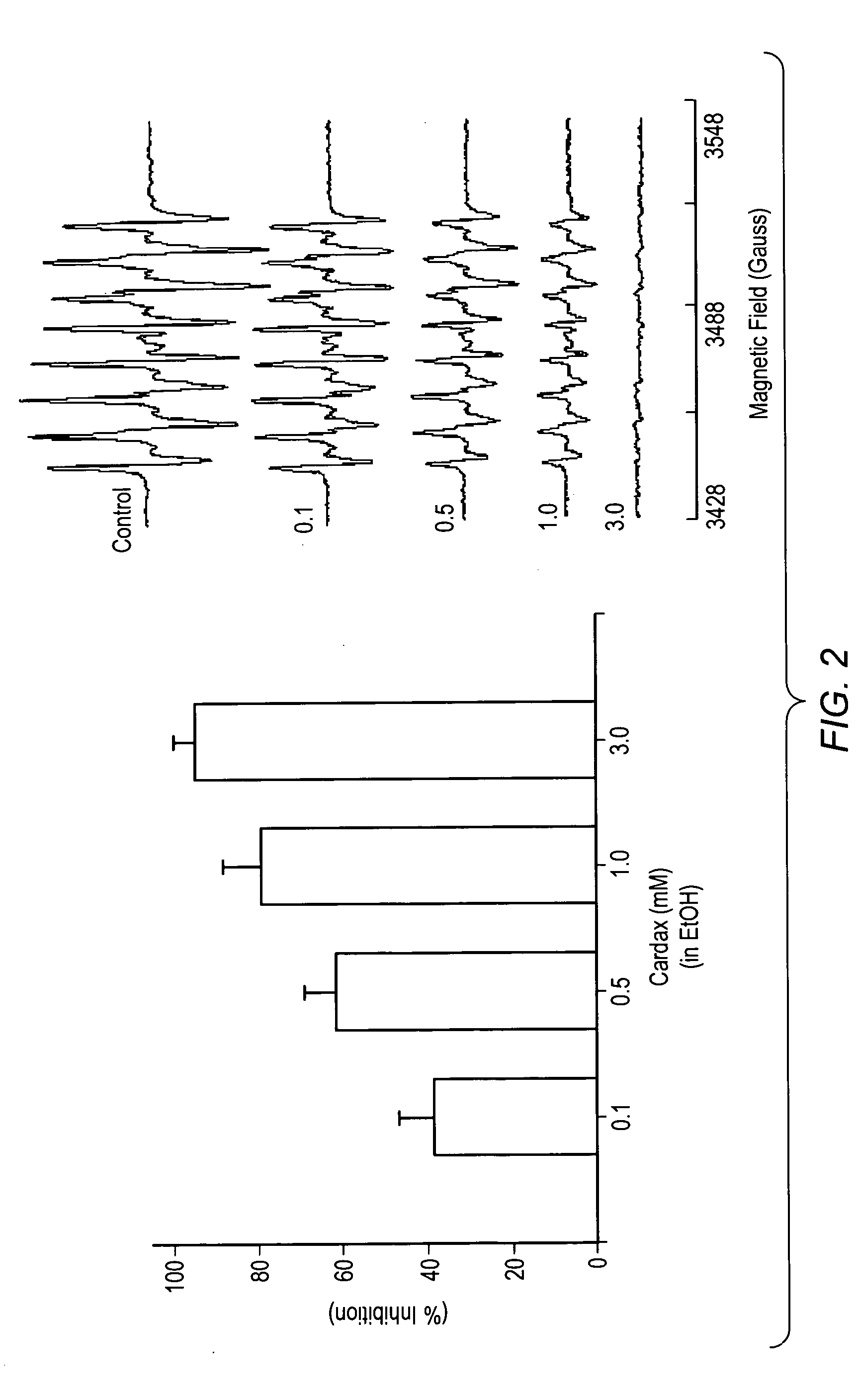Pharmaceutical compositions including carotenoid analogs or derivatives for the inhabition and amelioration of disease
a technology of carotenoid analogs and compositions, applied in the field of medicinal and synthetic chemistry, can solve the problems of ischemia, the lack of oxygenated blood supply to a particular, and the leading cause of cvd deaths in the world, so as to improve the proliferation and propagation, inhibit the proliferation rate of carcinogen-initiated cells, and increase the expression of connexin 43
- Summary
- Abstract
- Description
- Claims
- Application Information
AI Technical Summary
Benefits of technology
Problems solved by technology
Method used
Image
Examples
example 1
Synthesis of XV (the Disuccinic Acid Ester of Astaxanthin (Succinic Acid mono-(4-{18-[4-(3-carboxy-propionyloxy)-2,6,6-trimethyl-3-oxo-cyclohex-1-enyl]-3,7,12,16-tetramethyl-octadeca-1,3,5,7,9,11,13,15,17-nonaenyl}-3,5,5-trimethyl-2-oxo-cyclohex-3-enyl) ester))
To a solution of astaxanthin 2E (6.0 g, 10.05 mmol) in DCM (“dichloromethane”) (50 mL) at room temperature was added DIPEA (“N,N-diisopropylethylamine”) (35.012 mL, 201 mmol), succinic anhydride (10.057 g, 100.5 mmol), and DMAP (“4-(dimethylamino)pyridine”) (0.6145 g, 5.03 mmol). The reaction mixture was stirred at room temperature for 48 hours, at which time the reaction was diluted with DCM, quenched with brine / 1M HCl (60 mL / 10 mL), and then extracted with DCM. The combined organic layers were dried over Na2SO4 and concentrated to yield astaxanthin disuccinate (XV) (100%) HPLC retention time: 10.031 min., 82.57% (AUC); LRMS (ESI) m / z (relative intensity): 798 (M++2H) (52), 797 (M++H) (100); HPLC retention time: 10.595 min....
example 2
Synthesis of XVI (the Disodium Salt of the Disuccinic Acid Ester of Astaxanthin (Succinic Acid mono-(4-{18-[4-(3-carboxy-propionyloxy)-2,6,6-trimethyl-3-oxo-cyclohex-1-enyl]-3,7,12,16-tetramethyl-octadeca-1,3,5,7,9,11,13,15,17-nonaenyl}-3,5,5-trimethyl-2-oxo-cyclohex-3-enyl) ester))
Disuccinic acid ester of astaxanthin XV (2 g, 2.509 mmol) and 200 mL ethanol were stirred at room temperature under nitrogen in a 500 mL round-bottom flask. Sodium ethoxide (340 mg, 5.019 mmol, Acros #A012556101) was added as a solid in a single portion and the solution was allowed to stir overnight. The following day, the precipitate was filtered off and washed with ethanol followed by methylene chloride to afford a purple solid, the disodium salt of the disuccinic acid ester of astaxanthin, XVI [1.41 g, 67%] and was placed on a high vacuum line to dry. 1H-NMR (Methanol-d4) δ 6.77-6.28 (14 H, m), 5.53 (2 H, dd, J=12.6, 6.8), 2.68-2.47 (8 H, m), 2.08-1.88 (22 H, m), 1.37 (6 H, s), 1.24 (6H, s); 13C NMR ...
example 3
Synthesis of the BocLys(Boc)OH Ester of Astaxanthin (XXI)
HPLC: Column: Waters Symmetry C18 3.5 micron 4.6 mm×150 mm; Temperature: 25° C.; Mobile phase: (A=0.025 % TFA in H2O; B=0.025% TFA in MeCN), 95% A / 5% B (start); linear gradient to 100% B over 12 min, hold for 4 min; linear gradient to 95% B / 5% A over 2 min; linear gradient to 95% A / 5% B over 4 min; Flow rate: 2.5 ml / min; Detector wavelength: 474 nm.
To a mixture of astaxanthin 2E (11.5 g, 19.3 mmol) and BocLys(Boc)OH (20.0 g, 57.7 mmol) in methylene chloride (500 mL) were added 4-dimethylaminopyridine (DMAP) (10.6 g, 86.6 mmol) and 1,3-diisopropylcarbodiimide (“DIC”) (13.4 g, 86.7 mmol). The round-bottomed flask was covered with aluminum foil and the mixture was stirred at ambient temperature under nitrogen overnight. After 16 hours, the reaction was incomplete by HPLC and TLC. An additional 1.5 equivalents of DMAP and DIC were added to the reaction and after 2 hours, the reaction was complete by HPLC. The mixture was then ...
PUM
 Login to View More
Login to View More Abstract
Description
Claims
Application Information
 Login to View More
Login to View More - R&D
- Intellectual Property
- Life Sciences
- Materials
- Tech Scout
- Unparalleled Data Quality
- Higher Quality Content
- 60% Fewer Hallucinations
Browse by: Latest US Patents, China's latest patents, Technical Efficacy Thesaurus, Application Domain, Technology Topic, Popular Technical Reports.
© 2025 PatSnap. All rights reserved.Legal|Privacy policy|Modern Slavery Act Transparency Statement|Sitemap|About US| Contact US: help@patsnap.com



